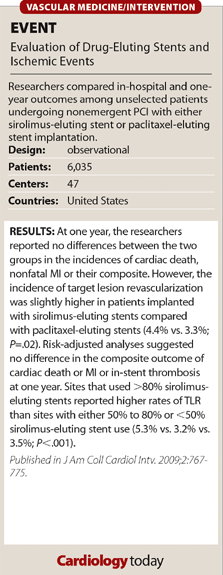EVENT: No differences in outcomes between sirolimus-eluting and paclitaxel-eluting stent at one year
Results from a registry of patients who received either sirolimus-eluting stents or paclitaxel-eluting stents revealed similar rates of clinically important restenosis and ischemic complications at one year.
Researchers for the EVENT registry enrolled 6,035 consecutive patients undergoing nonemergent percutaneous coronary intervention with either a sirolimus-eluting stent (n=3,443; Cypher, Cordis) or a paclitaxel-eluting stent (n=2,592; Taxus, Boston Scientific). The primary endpoint of the registry was the composite of cardiac death or MI at one year.
The researchers reported no difference in the incidence of angiographic success between those who received sirolimus-eluting stents and those who received paclitaxel-eluting stents (P=.30). They also reported a trend toward more frequent periprocedural MI in patients receiving paclitaxel-eluting stents vs. sirolimus-eluting stents (7.1% vs. 6.0%; P=.07). At one year, the researchers reported no differences between the two groups in the incidences of cardiac death, nonfatal MI or their composite.
However, the incidence of target lesion revascularization was slightly higher in patients implanted with sirolimus-eluting stents compared with those receiving paclitaxel-eluting stents (4.4% vs. 3.3%; P=.02). Risk-adjusted analyses suggested no difference in the composite outcome of cardiac death or MI or in-stent thrombosis at one year. Sites that used >80% sirolimus-eluting stents had higher rates of TLR than sites with either 50% to 80% or <50% sirolimus-eluting stent use (5.3% vs. 3.2% vs. 3.5%; P<.001).
“In this multicenter registry of nonemergent PCI with two types of drug-eluting stents, we found that adjusted one-year rates of both ischemic complications as well as clinically important restenosis were comparable for sirolimus-eluting stents and paclitaxel-eluting stents across a broad range of patient and lesion characteristics,” the researchers concluded.

Novack V. J Am Coll Cardiol Intv. 2009;2:767-775.
